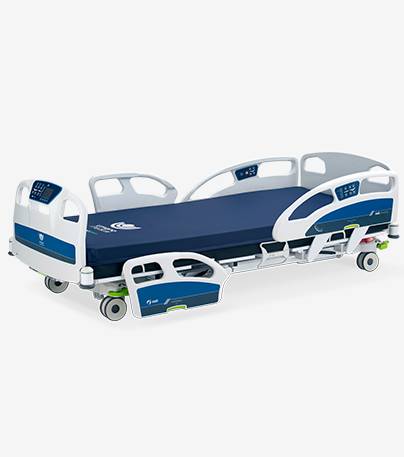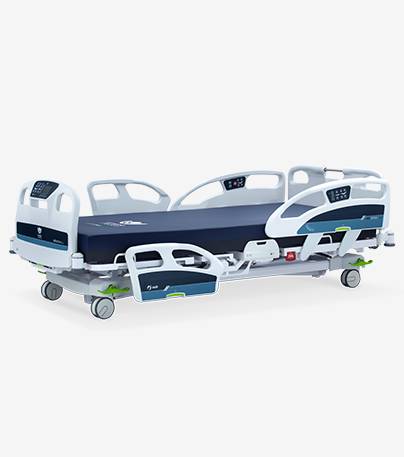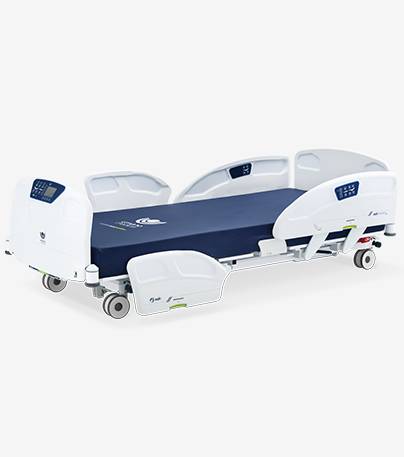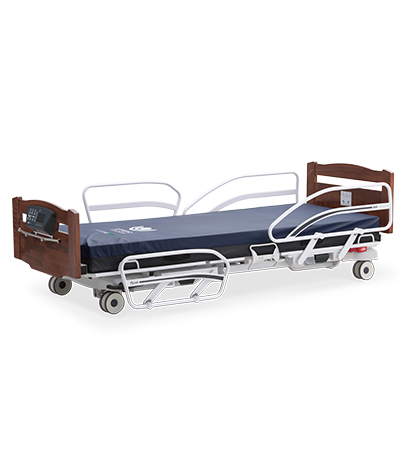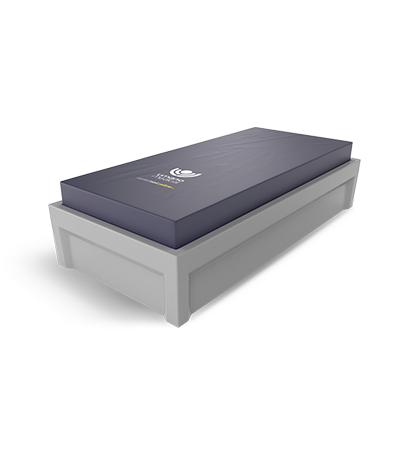
The evolution of pressure injury care: Choosing therapeutic support surfaces with microclimate management with air flow (LAL)

By Élisabeth Champagne
Directrice marketing et ventes internationales
Published on October 30, 2024
The evolution of pressure injury care: Choosing therapeutic support surfaces with microclimate management with air flow (LAL)
Support surfaces with microclimate management with air flow (LAL) and alternating air therapy have long been used to help prevent and treat pressure injuries in hospitals. By reducing heat and moisture buildup while a patient is in bed, these surfaces contribute to minimizing the effect of prolonged pressure, friction, and shear, especially over bony prominences.
Nevertheless, limitations remain with conventional therapeutic mattresses in hospital and long-term care settings. This article will explore these limitations as well as innovations in therapeutic support surfaces that are ushering in a new era of preventative and therapeutic pressure injury care and patient quality of life.
Therapeutic support surfaces
What are therapeutic support surfaces? Therapeutic support surfaces refer to mattresses designed to provide various therapies that help redistribute pressure, minimize shear and friction, and control heat and moisture. These features are essential for preventing and promoting the healing of pressure injuries.
Type of therapeutic support surfaces
Therapeutic support surfaces can be categorized into two types: reactive and active. Reactive surfaces are non-powered and redistribute pressure only when the patient's weight is applied. These therapeutic mattresses reduce interface pressure using immersion and envelopment.
Active surfaces, or dynamic surfaces, require a power source to adjust pressure redistribution mechanically through a control unit, offering tailored therapies for patients at higher risk for pressure injuries. These types of support surfaces change the interface pressure points of a patient’s body—even if they do not move.
Microclimat Management with Air flow (LAL)
Mircoclimat management (MCM) is a specialized feature available on a support surface that help with the prevention and treatment of pressure injuries, particularly for patients who are bedridden or have limited mobility. These mattresses are designed with top covers to allow air to circulate, regulating patients’ skin temperature and moisture. In some case, a control unit is pushing an air flow into the surface to increase the effect of the microclimate management.
How the microclimate management with air flow is helping
By fostering a drier bed environment, MCM with airflow can reduces the risk of skin breakdown caused by excess moisture, which can exacerbate pressure injuries. The constant flow of air also assists in the management of heat, which can contribute to skin irritation and tissue damage.
On the downside, some air mattresses can offer too much of a cushiony feel, which can compromise comfort as well as make it difficult for patients to move around in and get out of bed. Patients may feel as though therapeutic mattresses are unstable and are “swallow them up.”
Is your support surface limiting patient care?
Alternating air mattresses
Alternating air mattresses are specialized therapeutic support surfaces featuring multiple air cells that inflate and deflate in a cyclic pattern, usually every few minutes.
This alternating inflation and deflation process shifts the pressure points on the patient's body, promoting better blood circulation and reducing the risk of prolonged pressure on any single area.
A continuous alternation
As therapeutic mattresses, alternating air mattresses have the ability to redistribute pressure continuously, which contributes to alleviating stress on the skin and underlying tissues. Nevertheless, a study showed that:
“The alternating sensation is disliked by some patients and can cause feelings of nausea and affect sleep. In addition, on patient movement, the air-filled pockets are compressed, and patients find it difficult to mobilize in bed and also report feeling unstable at the mattress edge when they are getting in and out of bed or feeling like they will be ‘rolled out of bed,’ creating an unsafe feeling.23,32,33 Other issues include noise from the pump, technical failure and attendant alarms.”
Other legacy foam mattresses, made from low-quality, dense one-piece foam, can also trap heat and moisture, which can trigger the development of pressure injuries.
Hybrid foam-gel therapeutic surfaces
Hybrid foam-gel therapeutic mattresses can offer more support, distributing the patient's weight evenly. These mattresses are typically more lightweight and durable and can require less maintenance compared to other therapeutic support surfaces. They also can provide a more comfortable, stable surface without the sinking, cumbersome feel of air mattresses, which can lead to a more restful environment for patients.
Microclimate management on reactive surfaces
Some hybrid foam-gel support surfaces, like the oneNEST S, can provide an environment benefit to microclimate thanks to their material choice (top cover) . Onenest S top cover is breathable enough to allow humidity and moisture evaporation, it can also work to limit fluid ingress into the surface core. The oneNEST S is a reactive support surface that treat pressure injuries from stage 1 to 4, DTI, and unstageable. Learn more about the oneNEST S.
The good news is additional innovations in therapeutic support surfaces are bringing a new level of performance to maximize MCM even more while also providing a high level of comfort, stability and durability.
Enter the oneNEST M.
What is the oneNEST M?
The oneNEST M full body support surface by Umano Medical brings together the best of both worlds.
This convertible, hybrid foam-gel, therapeutic full body support surface by Umano Medical has been specifically engineered to maximize microclimate management and patient experience. Let’s take a look at the features in more detail:
- Microclimate management with airflow (LAL) system: The oneNEST M features a quiet, non-disruptive low air loss microclimate management with airflow system with 10 innovative air vents strategically placed under the typically warmest parts of patients’ bodies for optimal heat and humidity control. This advanced MCM system supports the prevention and treatment of pressure injuries stages 1-4, unstageable, and deep tissue injuries.
- Next-generation foam-gel mattress: The oneNEST M’s premium foam construction and design is specifically organized into specialty zones to maximize performance and clinical efficacy. It provides more tailored pressure distribution and stability, all while fostering a sense of deep immersion and envelopment. In addition, the therapeutic surfaces’ highly breathable top cover, made from a two-way stretch polyurethane fabric, welded seams and rigid flaps, has been specifically developed to reduce friction and shear, while also helping support robust infection prevention protocols.
- Patent-pending SafeBoostTM technology: Umano Medical’s SafeBoostTM integrated air cushion, which is positioned directly under the therapeutic foam core, assists with patient repositioning as well as bed ingress and egress. SafeBoost’s exclusive design creates a temporary boosting effect underneath the patient to enhance patient mobility and safety.
- Durable, yet lightweight: The oneNEST M therapeutic support surface is lighter than other therapeutic mattresses, facilitating handling and transportation. The handles are welded as opposed to being sewn — even after prolonged use, they simply do not rip off.
In conclusion, the choice of therapeutic support surface can significantly impact patient outcomes. The oneNEST S and the oneNEST M both offer advanced pressure redistribution through their unique and strategically placed hybrid foam-gel cores. Their designs are centered on patient comfort and long-term durability. In addition, the oneNEST M provides effective microclimate management with airflow through the addition of the quiet control unit and the technology of its breathable layers.
For healthcare providers, selecting the right mattress is not just about addressing immediate patient needs but also about investing in a solution that offers long-term benefits for both patients and healthcare workers. The oneNEST M sets a new standard in hybrid foam-gel therapeutic mattresses, enabling healthcare facilities to deliver superior patient and employee experiences.
Are you actively working to improve patient care?
About the author

Élisabeth Champagne
More articles form Élisabeth Champagne

Headquarters
230 Nilus-Leclerc Blvd.
L'Islet, QC G0R 2C0
CANADA
1 844 409-4030
Lévis Office
470 3e Avenue
Lévis, QC G6W 5M6
CANADA
US Location
11845 Adie Rd.
Maryland Heights, MO 63043
UNITED STATES
Sherbrooke Office
670, Joseph-Louis-Mathieu Rd.
Sherbrooke, J1R 0X3
CANADA
Careers
Our talented and passionate team is determined to revolutionize the medical industry. Be part of the journey: join the Umano Experience.
See available jobsConnect with us
Copyright © 2025 Umano Medical inc

